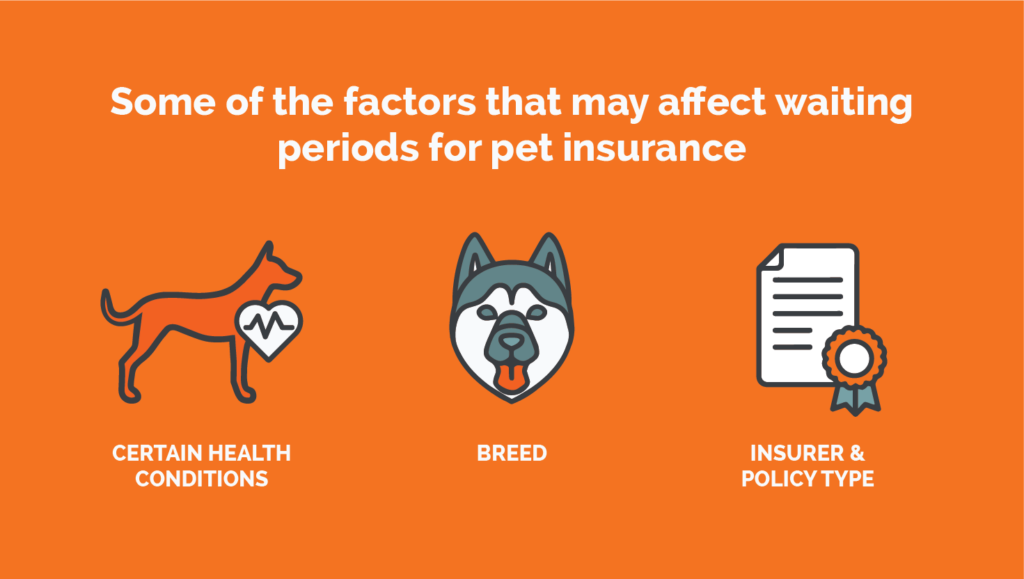Waiting periods for pet insurance
Waiting periods for pet insurance
*iSelect’s partnered with Choosi Pty Ltd to compare a range of pet insurers and policies. Not all policies are available at all times or in all areas. Our advice on this website is general in nature and does not consider your situation or needs. Consider if any advice is appropriate for you before acting on it. Learn more.
Easily compare Pet Insurance
We’ve partnered with Choosi to help you compare pet insurance policies.*
What are waiting periods?
What conditions might waiting periods affect?
Do all conditions have waiting periods?
What happens if I change insurers?
Can I change policies with my insurer?
Where can I compare my options?
So below, we’ll discuss waiting periods and how they work.
What are waiting periods?
With pet insurance, your insurer may agree to pay a portion of your pet’s vet bills for certain eligible conditions and treatments.
However, some conditions come with waiting periods. As noted by MoneySmart,1ASIC’s MoneySmart this is how long you need to wait between the start date of your policy and being able to make an eligible claim.
So, essentially, you might not be able to have an eligible claim for a particular injury or illness the moment your policy is approved. Instead, your insurer may first require you to hold the policy for a specific length of time before cover for that injury or illness will be provided.
What conditions might waiting periods affect?
This will ultimately depend on the details of the specific policy.
However, some common conditions which have waiting periods include:
- Cruciate ligament conditions
The “cruciate ligament” joins the bones above and below the knees for cats and dogs. Tears and ruptures in this ligament are also more common among certain dog breeds. - Illnesses
Most insurers define an illness as any kind of sickness or disease, including cancer, skin conditions and gastrointestinal problems. A 30-day waiting period for illnesses is not uncommon, though this can vary depending on the insurer. - Tick paralysis
Some insurers may also impose waiting periods on “tick paralysis”. This occurs when a tick bites your pet and injects a toxin that can paralyse their muscles – which could potentially prove fatal.
It’s worth noting that waiting periods may also vary between insurers. Some insurers might not impose waiting periods on certain conditions, where others may.
To find out the specifics, it’s important to check the pet insurance policy’s product disclosure statement. As this document will outline which conditions and treatments have waiting periods attached.

Do all conditions have waiting periods?
In short, no.
Many pet insurance policies do not impose waiting periods on accidental injuries, including those that result in burns, wounds or broken bones.
Again, this may not be the case with every insurer. So check the specific policy’s product disclosure statement to make sure.
What happens if I change insurers?
There are a number of reasons people change pet insurance providers.
Sometimes the new provider offers more competitive premiums; sometimes their policies include attractive optional extras.
However, in most cases, switching insurers means a new waiting period. This means that your pet may go without cover for certain conditions – at least for a time.
Can I change policies with my insurer?
Some insurers may allow you to upgrade your pet insurance policy so that it provides a higher level or cover or more benefits. Alternatively, they might let you scale back your policy to a less expensive option if your financial circumstances change.
In such cases, the insurer might not require you to sit through the waiting periods all over again, because you’re not changing insurers, the new cover could simply take over from the old one. However, this also depends on the specific insurer, and you’ll want to check with them to make sure the new cover is continuous.
Where can I compare my options?
If you’re looking for pet insurance, then we might be able to help.
At iSelect*, we’ve partnered with Choosi to help you compare pet insurance policies from Choosi’s range of providers and policies online. Explore your options with a press of a button today!
Last Updated: 27/06/2022

.svg)




